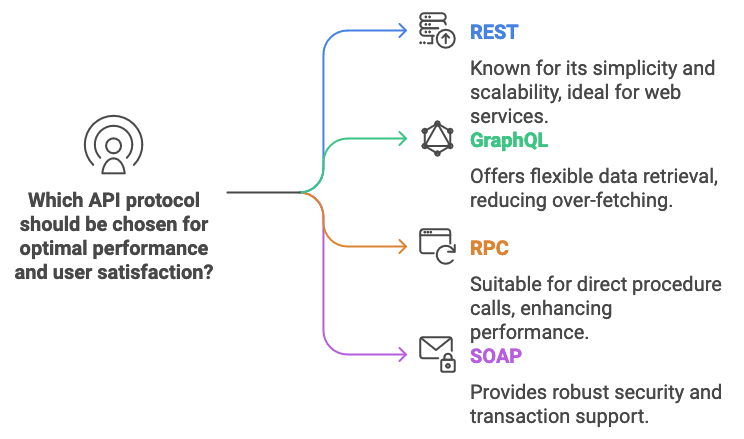Unlocking the Secrets of API Protocols: Which One is Best for You?
In today’s tech world, APIs (Application Programming Interfaces) are the backbone of seamless digital experiences, allowing applications to communicate and share data. But with several different API protocols out there, it can be tricky to decide which one best suits your project needs. In this blog, we’ll walk through popular API protocols—REST, GraphQL, RPC, SOAP, and others—and outline their strengths, use cases, and differences.
Let’s dive into the world of API protocols to help you make the right choice for your next project!
What is an API Protocol?
An API protocol defines how data is structured and transmitted between systems. Choosing the right protocol is essential for performance, scalability, and overall efficiency in your application.
Key API Protocols to Know
1. REST (Representational State Transfer)
Overview: REST is one of the most widely used protocols, designed to be stateless and highly scalable. RESTful APIs follow a standardized HTTP request-response model (GET, POST, PUT, DELETE).
Strengths:
Simple and easy to understand.
Compatible with web services (HTTP).
Great for public APIs and micro services.
Use Case: Ideal for web applications and mobile apps that need to interact with a large number of resources.
2. GraphQL
Overview: Created by Facebook, GraphQL allows clients to request specific data, eliminating the need to over-fetch or under-fetch information. It offers flexibility to request only the data fields you need.
Strengths:
Efficient data retrieval with a single request.
Reduces network usage and optimizes performance.
Perfect for complex systems with many data types and relationships.
Use Case: Ideal for applications with complex, data-heavy interactions, such as social media platforms or e-commerce sites.
3. RPC (Remote Procedure Call)
Overview: RPC allows a client to execute a function on a remote server as if it were local. RPC protocols, like gRPC (by Google), are often used to achieve high performance and low latency.
Strengths:
High-speed communication due to binary transmission.
Great for low-latency needs.
Effective for micro services in distributed systems.
Use Case: Suitable for real-time applications, such as video streaming services, and inter micro service communication.
4. SOAP (Simple Object Access Protocol)
Overview: SOAP is an older protocol that uses XML to encode requests and responses. It provides a higher level of security and supports complex transactions.
Strengths:
High security with built-in standards.
Suitable for enterprise-level applications.
Better error handling and ACID compliance for complex transactions.
Use Case: Commonly used in industries where security and reliability are essential, such as banking and telecommunications.
5. WebSockets
Overview: WebSockets provide a full-duplex communication channel over a single, long-lived connection, making it ideal for real-time applications.
Strengths:
Real-time data transfer.
Low latency due to persistent connection.
Perfect for live data streaming.
Use Case: Best for chat applications, gaming, and live streaming platforms that require real-time updates.
Quick Comparison of API Protocols
Here’s a handy flow diagram comparing each protocol’s strengths and weaknesses:

Choosing the Right API Protocol
Your choice of API protocol will depend on factors like performance, data needs, security, and project requirements. Here’s a quick guide to help you decide:
If you need high performance and low latency (e.g., for internal services): RPC is a strong choice.
If your application handles sensitive data and requires high security: SOAP is recommended.
If you want a flexible, efficient way to fetch data with minimal over-fetching: GraphQL is ideal.
For general web and mobile applications where ease of use is key: REST is a good fit.
If your app requires real-time updates (e.g., chat or live data): WebSockets provide the best performance.
Conclusion
APIs are crucial for modern applications, and choosing the right protocol is essential for achieving optimal performance and user satisfaction. Whether you go with REST, GraphQL, RPC, SOAP, or WebSockets, each protocol brings unique strengths to specific use cases.
In today’s rapidly evolving digital landscape, understanding these protocols can make all the difference in building a scalable, efficient, and user-friendly application.
Stay Ahead in Software Development!
Subscribe to Our Newsletter and Get:

Expert tips on system design and software engineering.

Insights into the latest tech trends.

Exclusive guides and tutorials straight to your inbox.
Join our growing community of developers building the future!
Sign up now and never miss an update.
The form can be filled in the actual website url.


